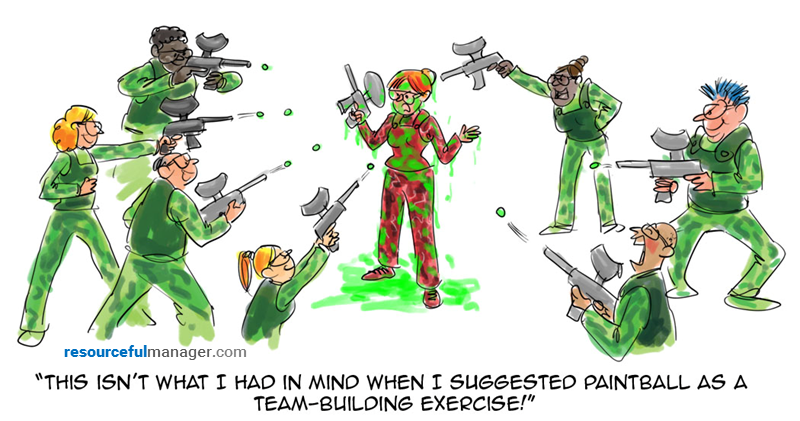Friendship at work is much more than having a buddy to lunch with. Workplace friendships improve morale, culture and business results.
Employee Engagement
Employee engagement is about creating an environment where employees are committed to the organization's mission and goals and are feeling fulfilled. These posts will help you create that environment.
4 Tactics to Help Employees Cut Stress (Seriously, You Can Do This)
The Great Resignation, The Great Reshuffle, Quiet Quitting, Quiet Firing … they have one thing in common: They’re a response to stress.
Why the Water Cooler – and 4 Other Office Mainstays – Still Matter Today
Ah, the humble water cooler – the keeper of all secrets and inventor of all great ideas in an office. It’s so important to office success, it went virtual with us when the pandemic sent many home to work. The water cooler is just one office mainstay that holds our professional places and lives together. […]
5 Ways to Keep Hybrid Employees Engaged – Wherever They Are
Employee engagement is down – and it’s especially difficult to keep hybrid employees engaged. In fact, engagement was dipping before COVID-19 came into the picture.
6 Lessons You Can Still Learn From Your 3rd Grade Teacher
One of the most important things you do each day is help your employees become better. Yet, only about 10% of managers say their jobs are structured so they can focus on coaching employees and creating training lessons.
When Your Staff Is Afraid To Be Honest With You
“Just be honest with me.”
Have you caught yourself in one of these conversations with an employee?
Whenever a manager feels the need to cajole an employee into being honest, there’s a larger problem at hand aside from guilty fibs or little white lies.
It might be that members of your team are afraid to be totally honest with you. Why? The hidden reason could be coming from your company culture – or even directly from you!
Some leaders don’t want to hear honest-to-goodness assessments because they might also have to hear some bad news. In some cases, opening themselves up to honest assessments from employees is as welcome as a root canal.
And employees almost always pick up on the sense that the unfiltered truth may be less than welcome with certain bosses, managers or other colleagues, especially when there are critical decisions on the line.
They create a “don’t go there!” rule in their minds and self-censor when being honest means a critical or negative response.
5 Ways To Better Coach Employees: It’s About Them, Not You
“I feel like I’m not getting through to them.”
“Don’t they hear what I’m saying?”
“They just don’t listen to me!”
Any time we try to teach and can’t get employees to catch on, it’s frustrating.
We pride ourselves on being good coaches. So, when we can’t seem to get employees on the same page, it saps even the most patient manager.
But before pinning the blame on the employee, consider that the problem could be coming from you.
A crucial part of coaching is to play to the person’s strengths.
It’s useless to coach a 350-pound lineman to be a fleet-footed wide receiver. It helps to think of your employees the same way.
“Coach employees to their strongest abilities and the lessons will pay off,” says David Lee, founder of HumanNature@work.
8 Must-Have Management Traits That Inspire Employees
To light a fire under employees – and keep it burning – be an inspiration.
Employees with inspirational bosses are engaged, productive, reliable and loyal, a Gallup poll found.
Almost all of those who don’t have an encouraging boss are actively disengaged.
How can you inspire employees? Do what inspirational bosses have in common:
10 Team-Building Exercises Your Crew Will Actually Hate
Experts say team-building exercises can be very successful when done right. They foster trust, promote communication and increase collaboration among employees.
Problem is, they’re seldom done right. And they become team-breaking exercises.
Just the mere mention of those three little words – team-building exercises – can make some people cringe and call out sick.
Can’t blame them. Too often the activities are humiliating or just downright stupid.
Don’t believe me?
Check out these examples of team-breaking, er, team-building exercises gone wrong:
12 Warning Signs Your Best Employee Is About To Quit
Wouldn’t it be great if star employees never left?
But we all know, that at some point something will happen that’ll cause one of your “A” players to leave.
What that “something” is may not be in your control.
Problem is, employee turnover costs companies A LOT of money!
Direct employee replacement costs can reach as high as 50% to 60% of an employee’s annual salary, according to the Society for Human Resource Management. And when other factors are included, total costs can soar as high as 90% to 200% of an annual salary.
That’s some serious moola!
So what can you do?
Pay attention to your employees and watch for signs that they may be getting restless, and nip it in the bud.
The typical signs are:
- « Previous Page
- 1
- 2
- 3
- 4
- …
- 6
- Next Page »









